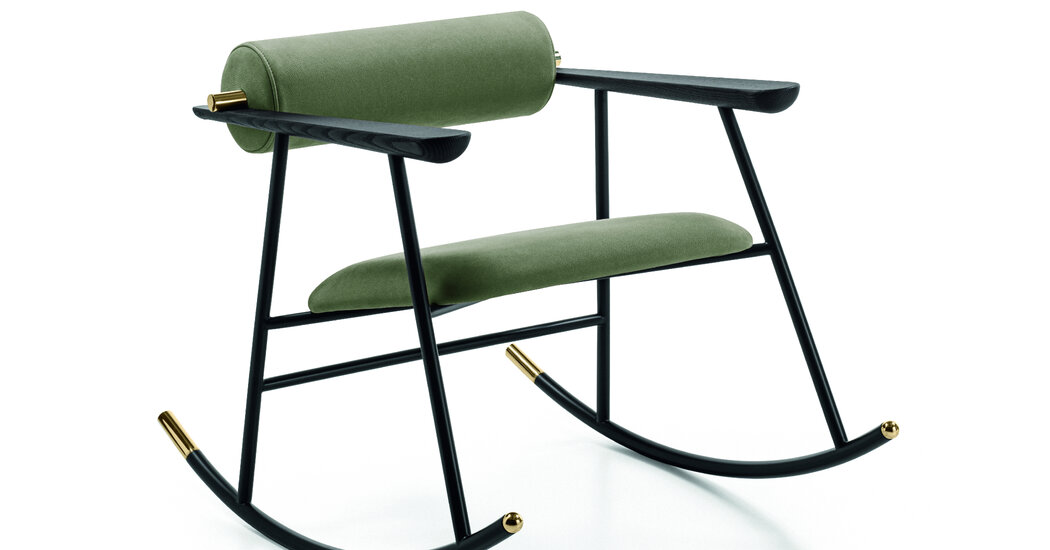
Milan Design Week: Lounging and Reflecting
This article is part of our Design special report previewing Milan Design Week.
Chairs are to design fairs what apple pies are to state fairs: comfortable fixtures with (at least) 10,000 variations. At Milan Design Week, the new introductions include some popular repeats, like Patricia Urquiola’s Tufty-Time sofa for B&B Italia, now in its fourth version in two generations. Facing the future is the Psukhe armchair, an aerodynamic-looking stasis demon by Felix Godard, who is better known for designing the interiors of electric cars.
A Reimagined Rocking Chair
David Raffoul and Nicolas Moussallem’s Loulou rocking chair was originally presented in 2014 as part of “Loulou/Hoda,” an exhibition in the designers’ native Beirut, Lebanon. The show was named after their respective grandmothers and featured pieces that, Mr. Raffoul noted, “would be found in any Lebanese grandmother’s home,” albeit reimagined for their generation. Meaning the rocking chair, Mr. Moussallem said, was “lower and a bit more loungey than a traditional rocking chair.”
“It holds your back in a relaxed position,” he continued, “you’re not sitting straight up.”
The founders of david/nicolas, who have a second studio in Milan, initially offered the upholstered rocker in an edition of 12. Two years ago, Mr. Raffoul posted a picture on Instagram of the chair in their Beirut office. The post caught the attention of Silvia Gallotti, the chief executive of the furniture company Gallotti & Radice, with whom they had previously collaborated.
The rocker, she said, “felt like more than just a piece of furniture — it had a strong personality and a unique presence that resonated with me instantly.” It is being introduced at Salone del Mobile under the assumption that it will resonate with others, too.
“Ten years ago our reach was very small,” Mr. Moussallem said. “I’m very curious to see how the public will react to it now.”
The Loulou rocking chair is on view Tuesday through Sunday at Salone del Mobile, Pavilion 9, stands E11/F10; gallottiradice.it. — RIMA SUQI
A Thing of Beauty and Harmony
The octogenarian Swiss architect Mario Botta dug deeply into his own past and decades of furniture history for inspiration while designing fiberboard pieces for the Italian manufacturer Alias.
Mr. Botta’s line of Zeta stools, which have zigzagging profiles, perforated rims and palettes of yellow, black, brown and gray, riff off the sharply angular wooden armchairs in red and blue that the Dutch designer Gerrit Rietveld introduced in the 1910s.
Mr. Botta said that he had long considered Rietveld “my master of essentiality,” whose primary-colored armchair remained “an archetype of beauty and harmony for a domestic object.” He added that in designing the stools, he also drew upon his memories of “the poorer and cheaper seats” of rural buildings that surrounded him during his childhood in southern Switzerland.
He was asked what reactions have been elicited by Zeta’s shape so far. Do the toothy edges perhaps remind people of piano keys, hair combs or the punched cards used on early computers? Have the diagonal braces been likened to crisscrossing bridge railings or skyscraper reinforcements? He simply replied that he welcomed maximally diverse interpretation: “The object of design cannot be univocal.”
The new line is part of the Alias presentation on view Monday through Sunday at Fondazione Luciana Matalon, 67 Foro Buonaparte; alias.design. — EVE M. KAHN
New Directions in Woodwork
“Bentwood was a new direction for them and for me,” said Yves Béhar, the Swiss-born designer whose San Francisco firm, Fuseproject, is better known for technology-driven work. He was referring to a stool he recently designed for Zanat, a 105-year-old Bosnian woodworking company that has reinvented itself by collaborating with leading international designers.
Orhan Niksic, Zanat’s chief executive, had known and admired Mr. Béhar’s work but only recently met him through the designer’s wife, Sabrina Buell, an art consultant Mr. Niksic knew from their college days at Stanford University.
“It did not worry me that Yves has not designed much wooden furniture,” Mr. Niksic wrote in an email. “What mattered was that we had a shared design vision and values.”
The stool started as a bench, changing in scale and shape as Mr. Béhar’s and Zanat’s artisans worked together. Its round legs split and bend into arches supporting a solid wood seat. “When you look at it from the top, it feels like a continuous pattern of curved, structural bentwood pieces like a cloverleaf,” Mr. Niksic said.
Named Rye, the stool is available in both counter and bar heights in a variety of woods. It is on view at the Salone del Mobile, Hall 22, stand A11; zanat.org. — ARLENE HIRST
An Evolution of Sitting in Comfort
When B&B Italia introduced its Tufty-Time sofa in 2005, the Patricia Urquiola design was meant to court a younger audience with a modern silhouette. The piece was inspired by Mario Bellini’s Camaleonda sofa, which had been out of production for more than 25 years, and featured similar, albeit less voluptuous, square tufts. Tufty-Time has been a best seller ever since.
This year, a fourth iteration, called Tufty-Time 20, will be introduced in honor of the sofa’s 20th anniversary. Previous versions, which appeared in 2011 and 2015, are still in production.
Demetrio Apolloni, B&B Italia Group’s chief executive, was with the company when Tufty-Time made its original entrance. Last year, after stints at Vitra, Cassina and Knoll, he returned. It was his idea to approach Ms. Urquiola about an update. (He recalled that she joked that as she was now in her 60s, it would be nice to have a version with a higher seat, making it easier to rise.)
Tufty-Time 20 in fact has a seat that is two centimeters (0.8 inches) loftier than previous models. The fatter cushions are a sandwich of polyurethane foam, recycled polyester batting and fabric. The sofa can be fully disassembled, meaning each component and material has the possibility of a second, post-Tufty-Time life. The modular group also includes a new, curved section that the company is betting will be popular with hotel designers.
“It’s like sitting at a circular table versus a rectangular one,” Mr. Apolloni said. “Everybody can see each other and have a conversation. It’s more social.”
Tufty-Time 20 will be displayed with other B&B Italia designs from Tuesday through Sunday at the company’s showroom at 14 Via Durini; bebitalia.com. — RIMA SUQI
Furniture Born of a Work of Fiction
Felix Godard, the French designer who has created interiors for electric vehicles at Tesla and Porsche, pushes himself to imagine designs that could exist only far in the future.
“After I reach the impossible idea, then I turn into an industrial designer who is trying to bring this idea back to life,” he said.
His first home furnishings for a collection called Psukhe, which will debut at the LABÒ Cultural Project, were initially born of a work of fiction — part art book and part sci-fi novel — called “Psukhetele” that Mr. Godard has been working on since 2008.
The book was initially created to inspire a movie or a video game. But after working to design and develop concept cars, Mr. Godard realized he had the expertise to bring some of his futuristic conceptions into reality.
“In this world, I imagine a lot of things,” he said of the book, “but furniture felt like the most natural thing to apply from my experience.”
The armchairs, which will be presented in a deep gray-blue as well as a white with hints of lavender, evoke the sleek trains and cars Mr. Godard is known for. They also share elements of Scandinavian design, which he described as “serene.” Clever engineering was used to balance the weight distribution, giving the seats the surreal effect that they’re balancing on their armrests.
“When you see the chair,” Mr. Godard said, “you feel like it’s almost flying.”
The exhibition is open Monday through Friday at 6 Via Biella; laboculturalproject.com. — LAUREN MESSMAN










